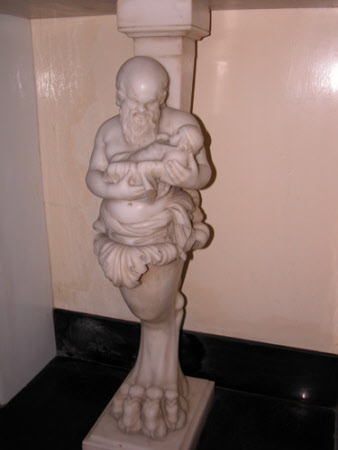A single-footed table (monopodium) with a herm in the form of Silenus holding the infant Bacchus
Italian School
Category
Art / Sculpture
Date
c. 1900 - 1935
Materials
Marble sculpture.
Measurements
50 x 835 x 356 mm
Place of origin
Italy
Order this imageCollection
Anglesey Abbey, Cambridgeshire
NT 516603
Summary
Sculpture, marble; herm in the form of Silenus holding the Infant Bacchus; Italian School, c. 1900-35. A large animal’s leg terminating in a lion’s paw foot, out of the top of the leg emerges the half-length figure of Silenus, cradling in his arms the infant Bacchus, god of wine. A modern copy of a Roman marble monopodium, a single-footed table used in Roman houses for the display of valued objects. The original Roman table-support was found in the so-called House of the Prince of Naples in Pompei. Lord Fairhaven incorporated his marble copy into the men’s urinals on the staircase leading from the Tapestry Hall at Anglesey Abbey.The original Roman table-support was found in the so-called House of the Prince of Naples in Pompei. Lord Fairhaven incorporated his marble copy into the men’s urinals on the staircase leading from the Tapestry Hall at Anglesey Abbey.
Full description
A modern copy of a Roman marble monopodium, a single-footed table used in Roman houses for the display of valued objects. A single large animal’s leg terminating in a lion’s paw foot, resting on a rectangular marble base. The top of the leg is in the form of a sprouting acanthus, out of which emerges the half-length figure of Silenus, cradling in his arms the infant Bacchus, god of wine. Silenus was a satyr who is said to have brought up and instructed the young Bacchus. Behind Silenus is a vertical support, to the top of which is fixed a grey marble table-top. After he and his brother had bought Anglesey Abbey in 1925, Lord Fairhaven made numerous additions and improvements to the architecture over a period of some thirty years. As part of works undertaken in 1937-38 he created, leading up from the Tapestry Hall on the ground floor, a new staircase incorporating a slip room designed as a male cloakroom, with two urinals at the far end. Lord Fairhaven incorporated his marble copy into these men’s urinals, placing the single-footed table (monopodium) between the two urinals, perhaps to provide a suitable surface on which users of the facilities could place objects. The Anglesey Abbey support is a close copy of a monopodium found in the House of the Prince of Naples (Casa del Principe di Napoli, house no. VI.15.8, excavated in 1896), where it was discovered standing in the middle of the house’s small garden (Parco Archeologico di Pompeii, SAP 53562. Cornelius Vermeule, ‘Bench and Table Supports: Roman Egypt and Beyond’ in eds. W. Kelly Simpson and W.M. Davies, Studies in Ancient Egypt, the Aegean and Sudan. Essays in honor of Dowys Dunham, Boston 1981, pp. 180-92, pp. 182, 188, no. 35, fig. 11; Paul Roberts, Last Supper in Pompeii, exh. cat., Ashmolean Museum, Oxford 2019, pp. 99-100, fig. 99, p. 260, cat. 97). The monopodium, an expensive luxury object, would in turn have probably been used for the display of a valuable item such as a bronze or marble statuette, or a bronze or silver vessel. It is almost certain that the copy would have been made in one of the many Neapolitan workshops that specialised in replicas of objects from Pompei and Herculaneum, among them Chiurazzi, which made reproductions in bronze, ceramics and marble (but in whose 1929 catalogue the monopodium is not listed). Another copy at Anglesey Abbey of a major object from Pompeii is the bronze situla (NT 515091). Jeremy Warren October 2021
Provenance
Bequeathed to the National Trust by Huttleston Rogers Broughton, 1st Lord Fairhaven (1896-1966) with the house and the rest of the contents.
Makers and roles
Italian School, sculptor
References
Christie, Manson & Woods 1971: The National Trust, Anglesey Abbey, Cambridge. Inventory: Furniture, Textiles, Porcelain, Bronzes, Sculpture and Garden Ornaments’, 1971, p. 147.


